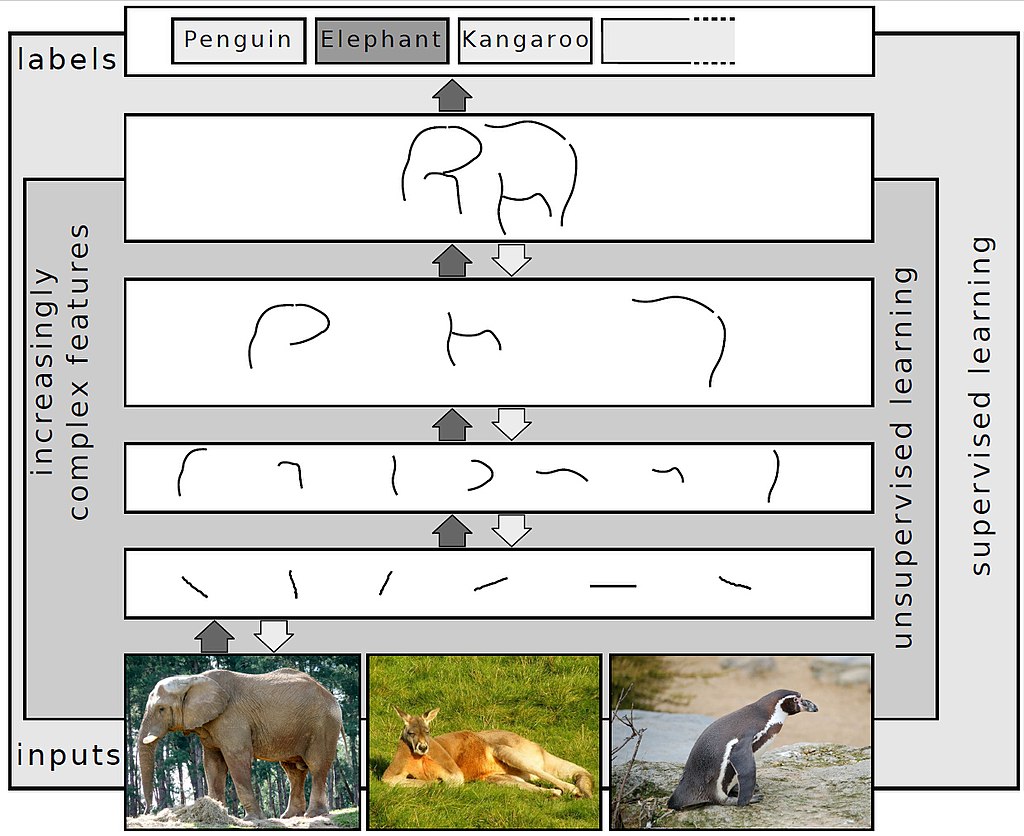Deep Learning
Simple definition of Deep Learning: Deep learning is a type of artificial intelligence derived from machine learning (automatic learning) where the machine is able to learn by itself, unlike programming where the predetermined rules applied.
Deep learning is a subfield of artificial intelligence (AI). This term designates the set of automatic learning techniques (machine learning), in other words a form of learning based on mathematical approaches, used to model data. To better understand these techniques, we must go back to the origins of artificial intelligence in 1950, the year during which Alan Turning became interested in machines capable of thinking.
How deep learning works
It works based on a network of artificial neurons inspired by the human brain. This network is made up of tens or even hundreds of “ layers ” of neurons, each receiving and interpreting information from the previous layer. The system will learn, for example, to recognize letters before attacking the words in a text, or determines if there is a face in a photo before discovering who it is.
At each stage, the “wrong” answers are eliminated and sent back to the upstream levels to adjust the mathematical model. Over time, the program reorganizes the information into more complex blocks. When this model is subsequently applied to other cases, he is normally able to recognize a cat without anyone ever telling him that he has never learned the concept of a cat. The starting data is essential: the more the system accumulates different experiences, the more it will perform.
Did you know?
If there is a profession where the need for expertise in Deep Learning is fundamental, it is that of data scientist. Indeed, this data specialist will be expected to use artificial intelligence techniques for Deep Learning. To do this, the data scientist must master Deep Learning tools such as Tensorflow and Keras. It is possible to train through specialized deep learning training.
Applications of deep learning
Deep Learning is used in many areas:
- image recognition,
- automatic translation,
- autonomous car,
- medical diagnosis,
- personalized recommendations,
- automatic moderation of social networks,
- financial prediction and automated trading,
- identification of defective parts,
- detection of malware or fraud,
- chatbots (conversational agents),
- space exploration,
- smart robots.
It is also thanks to deep learning that Google Alpha Go’s artificial intelligence managed to beat the best Go champions in 2016. The American giant’s search engine is itself increasingly based on learning by deep learning rather than written rules.
Today deep learning is even capable of “ creating ” paintings by Van Gogh or Rembrandt on its own, to invent a totally new language for communicating between two machines.
What is deep learning used for?
It is very useful in the world of information and communication technologies.
It is used in facial and voice recognition systems embedded in some smartphones, and in robotics so that smart equipment can have the expected reaction in a given situation (for example, a smart refrigerator that emits an alarm signal if it detects a door left open or an abnormal temperature within the compartments).
Wondering how Facebook, Instagram and TikTok recognizes your friends in the photos you post? You now have the answer: deep learning. Researchers, especially those who study and/or manipulate DNA, use deep learning to carry out their research.
These technologies are also present in automatic translation systems, in cars and other autonomous vehicles, in medicine to establish a diagnosis from an imaging examination (radio, MRI, CT scan), in physics to search for particles and in the artistic field to reproduce a work.

Schematic overview of layer-wise learning of feature hierarchies. Increasingly complex features are determined from input using unsupervised learning. The features can be used for supervised task learning. Sven Behnke, CC BY-SA 4.0, via Wikimedia Commons
How does deep learning work? cont’d
As inside the human brain, signals travel between neurons in the artificial brain. The secret of this feat is largely based on algorithms. In the case of visual recognition, to be effective, the deep learning algorithm must be able to identify all existing shapes and from all angles.
Thus, it will be able to detect a car on the road in the middle of the landscape. This is only possible if the machine has undergone extensive training. And this involves viewing thousands of photographs on which a car appears, of all shapes and from all possible angles.
When the new image appears, it is sent to the neural network which is responsible for analyzing them and determining whether the object in the middle of the shot is indeed a car. Has the machine won its bet? She keeps her correct answer warm, because it will help her solve other similar situations the day she has to recognize another car.
Viewpoints by learning functions
Supervised Learning
- End-to-end learning of depth architectures with backpropagation.
- Works well when the amount of tags is large.
- Structure of the model is important (eg convolutional structure)
Unsupervised learning
- Learn statistical structure or data dependencies from unlabeled data
- Formation by layers
- It is useful when the number of tags is not large.
Classification of feature learning method
| Method | Supervised | Unsupervised |
|---|---|---|
| Superficial |
|
|
| Deep |
|
|
Why is deep learning important?
We live in an age where the possibilities are endless and deep learning technology can help us achieve new technological advances. Deep learning has enabled the discovery of exoplanets and new drugs as well as the detection of diseases and subatomic particles. It greatly increases our understanding of biology, including genomics, proteomics, metabolomics, and immunonomics.
We constantly face new challenges. Climate change threatens food production and could one day cause wars over resource scarcity. This challenge will be all the greater as the world’s population continues to grow and is expected to reach 9 billion in 2050. The scope and scale of these problems require a new level of intelligence made possible by deep learning.
During the Cambrian Explosion around 540 million years ago, vision emerged as a survival advantage in animals and soon became the engine of evolution. In addition to the evolution of biological neural networks that made it possible to process visual information, vision also provided animals with a map of their environment and increased their awareness of the world around them.
Nowadays, the combination of cameras that act as an artificial eye and neural networks that can process visual information captured by the eyes is a real revolution for data-driven AI applications. Just as vision has played a crucial role in the evolution of life on Earth, deep learning and neural networks will help improve the capabilities of robots. They will be increasingly able to understand their environment, make autonomous decisions, collaborate with us and increase our own capacities.
Quantum Machine Learning | Power of Data, at the intersection of new technologies
Sources: PinterPandai, MathWorks, TechTarget, IBM
Photo credit: Geralt via Pixabay



